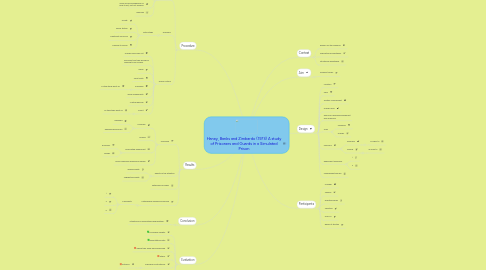
1. Procedure
1.1. Guards
1.1.1. Told to
1.1.2. Given administrative duties
1.1.3. helped set up the prison
1.1.4. Given minimal guidelines on how to act, but not allowed
1.1.5. Believed
1.2. Prisoners
1.2.1. Initial stage
1.2.1.1. 'Arrest'
1.2.1.2. Police station
1.2.1.3. Treatment by police
1.2.1.4. Transfer to prison
1.3. Prison routine
1.3.1. Guards read rules out
1.3.2. Prisoners told they would be referred to by number
1.3.3. Meals
1.3.4. Toilet visits
1.3.5. Privileges
1.3.5.1. As the study went on
1.3.6. Work assignments
1.3.7. Visiting periods
1.3.8. Count
1.3.8.1. As the study went on
2. Results
2.1. Overview
2.1.1. Prisoners
2.1.1.1. Released
2.1.1.2. Remaining prisoners
2.1.2. Guards
2.1.3. Terminated experiment
2.1.3.1. prisoners
2.1.3.2. guards
2.1.4. Some individual differences shown
2.2. Reality of the situation
2.2.1. lacking reality
2.2.2. Suggesting reality
2.3. Pathology of power
2.4. Pathological prisoner syndrome
2.4.1. 3 elements
2.4.1.1. 1
2.4.1.2. 2
2.4.1.3. 3.
3. Conclusion
3.1. Situational or dispositional explanation?
4. Evaluation
4.1. Ecological validity
4.2. Quantitative data
4.3. Aware they were being observed
4.4. Ethics
4.5. Individual vs situational
4.5.1. Entirely?
4.6. Generalisations
4.7. replication
4.8. Usefulness
5. Context
5.1. Reason for the research
5.2. Dispositional hypothesis
5.3. Situational hypothesis
6. Aim
6.1. Achieve this by
7. Design
7.1. Location
7.2. Cells
7.3. Solitary confinement
7.4. Guard's area
7.5. Room for recording equipment and observers
7.6. Time
7.6.1. Prisoners
7.6.2. Guards
7.7. Uniforms
7.7.1. Prisoners
7.7.1.1. In order to
7.7.2. Guards
7.7.2.1. In order to
7.8. Dependent measures
7.8.1. 1
7.8.2. 2
